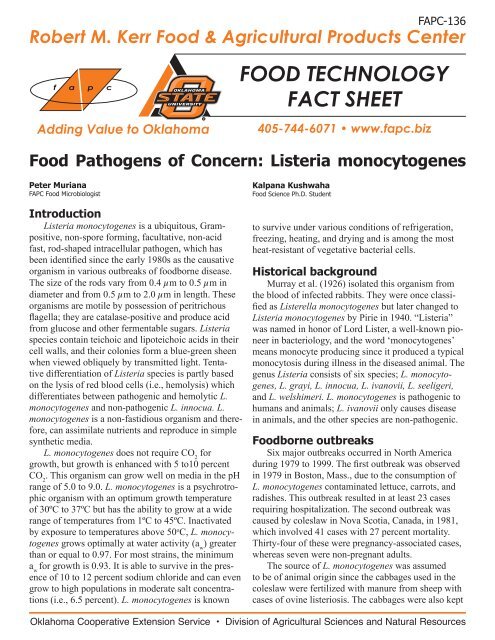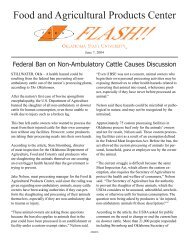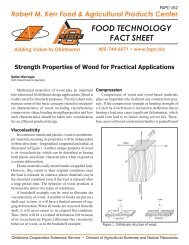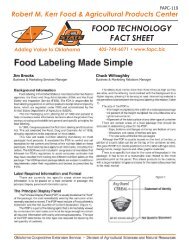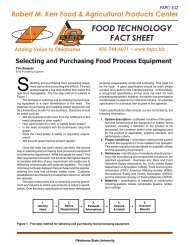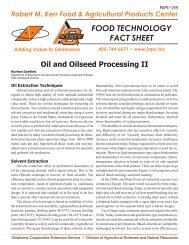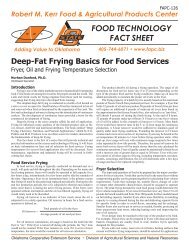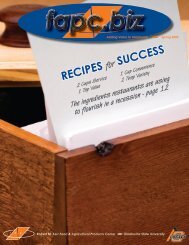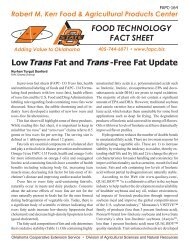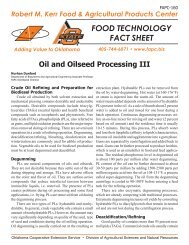Food Pathogens of Concern: Listeria monocytogenes
Food Pathogens of Concern: Listeria monocytogenes
Food Pathogens of Concern: Listeria monocytogenes
You also want an ePaper? Increase the reach of your titles
YUMPU automatically turns print PDFs into web optimized ePapers that Google loves.
FAPC-136 FAPC-165<br />
Robert M. Kerr <strong>Food</strong> & Agricultural Products Center<br />
f a p c<br />
Adding Value to Oklahoma<br />
FOOD TECHNOLOGY<br />
FACT SHEET<br />
405-744-6071 • www.fapc.biz<br />
<strong>Food</strong> <strong>Pathogens</strong> <strong>of</strong> <strong>Concern</strong>: <strong>Listeria</strong> <strong>monocytogenes</strong><br />
Peter Muriana<br />
FAPC <strong>Food</strong> Microbiologist<br />
Introduction<br />
<strong>Listeria</strong> <strong>monocytogenes</strong> is a ubiquitous, Grampositive,<br />
non-spore forming, facultative, non-acid<br />
fast, rod-shaped intracellular pathogen, which has<br />
been identified since the early 1980s as the causative<br />
organism in various outbreaks <strong>of</strong> foodborne disease.<br />
The size <strong>of</strong> the rods vary from 0.4 µm to 0.5 µm in<br />
diameter and from 0.5 µm to 2.0 µm in length. These<br />
organisms are motile by possession <strong>of</strong> peritrichous<br />
flagella; they are catalase-positive and produce acid<br />
from glucose and other fermentable sugars. <strong>Listeria</strong><br />
species contain teichoic and lipoteichoic acids in their<br />
cell walls, and their colonies form a blue-green sheen<br />
when viewed obliquely by transmitted light. Tentative<br />
differentiation <strong>of</strong> <strong>Listeria</strong> species is partly based<br />
on the lysis <strong>of</strong> red blood cells (i.e., hemolysis) which<br />
differentiates between pathogenic and hemolytic L.<br />
<strong>monocytogenes</strong> and non-pathogenic L. innocua. L.<br />
<strong>monocytogenes</strong> is a non-fastidious organism and therefore,<br />
can assimilate nutrients and reproduce in simple<br />
synthetic media.<br />
L. <strong>monocytogenes</strong> does not require CO 2 for<br />
growth, but growth is enhanced with 5 to10 percent<br />
CO 2 . This organism can grow well on media in the pH<br />
range <strong>of</strong> 5.0 to 9.0. L. <strong>monocytogenes</strong> is a psychrotrophic<br />
organism with an optimum growth temperature<br />
<strong>of</strong> 30ºC to 37ºC but has the ability to grow at a wide<br />
range <strong>of</strong> temperatures from 1ºC to 45ºC. Inactivated<br />
by exposure to temperatures above 50 o C, L. <strong>monocytogenes</strong><br />
grows optimally at water activity (a w ) greater<br />
than or equal to 0.97. For most strains, the minimum<br />
a w for growth is 0.93. It is able to survive in the presence<br />
<strong>of</strong> 10 to 12 percent sodium chloride and can even<br />
grow to high populations in moderate salt concentrations<br />
(i.e., 6.5 percent). L. <strong>monocytogenes</strong> is known<br />
Kalpana Kushwaha<br />
<strong>Food</strong> Science Ph.D. Student<br />
to survive under various conditions <strong>of</strong> refrigeration,<br />
freezing, heating, and drying and is among the most<br />
heat-resistant <strong>of</strong> vegetative bacterial cells.<br />
Historical background<br />
Murray et al. (1926) isolated this organism from<br />
the blood <strong>of</strong> infected rabbits. They were once classified<br />
as Listerella <strong>monocytogenes</strong> but later changed to<br />
<strong>Listeria</strong> <strong>monocytogenes</strong> by Pirie in 1940. “<strong>Listeria</strong>”<br />
was named in honor <strong>of</strong> Lord Lister, a well-known pioneer<br />
in bacteriology, and the word ‘<strong>monocytogenes</strong>’<br />
means monocyte producing since it produced a typical<br />
monocytosis during illness in the diseased animal. The<br />
genus <strong>Listeria</strong> consists <strong>of</strong> six species; L. <strong>monocytogenes</strong>,<br />
L. grayi, L. innocua, L. ivanovii, L. seeligeri,<br />
and L. welshimeri. L. <strong>monocytogenes</strong> is pathogenic to<br />
humans and animals; L. ivanovii only causes disease<br />
in animals, and the other species are non-pathogenic.<br />
<strong>Food</strong>borne outbreaks<br />
Six major outbreaks occurred in North America<br />
during 1979 to 1999. The first outbreak was observed<br />
in 1979 in Boston, Mass., due to the consumption <strong>of</strong><br />
L. <strong>monocytogenes</strong> contaminated lettuce, carrots, and<br />
radishes. This outbreak resulted in at least 23 cases<br />
requiring hospitalization. The second outbreak was<br />
caused by coleslaw in Nova Scotia, Canada, in 1981,<br />
which involved 41 cases with 27 percent mortality.<br />
Thirty-four <strong>of</strong> these were pregnancy-associated cases,<br />
whereas seven were non-pregnant adults.<br />
The source <strong>of</strong> L. <strong>monocytogenes</strong> was assumed<br />
to be <strong>of</strong> animal origin since the cabbages used in the<br />
coleslaw were fertilized with manure from sheep with<br />
cases <strong>of</strong> ovine listeriosis. The cabbages were also kept<br />
Oklahoma Cooperative Extension Service • Division <strong>of</strong> Agricultural Sciences and Natural Resources
for long periods <strong>of</strong> cold storage providing a growth<br />
advantage for the psychrotrophic L. <strong>monocytogenes</strong>.<br />
This was convincing evidence <strong>of</strong> foodborne transmission.<br />
In 1983, a large outbreak <strong>of</strong> listeriosis in Boston,<br />
Mass. was attributed to improperly pasteurized milk<br />
that had a case-fatality rate <strong>of</strong> 29 percent. Another<br />
outbreak occurred in 1985 in Southern California in<br />
which Mexican style cheese was implicated as the<br />
vehicle <strong>of</strong> infection. Pregnant women again accounted<br />
for 93 cases, or 65 percent, and the remaining 49 were<br />
nonpregnant adults.<br />
Typical sources for the transmission <strong>of</strong> L. <strong>monocytogenes</strong><br />
are contaminated foods consumed without<br />
further cooking such as fresh vegetables, luncheon<br />
meats, dairy products, smoked fish, and ready-to-eat,<br />
or RTE, meat products. The association <strong>of</strong> listeriosis<br />
with RTE foods has caused substantial problems for<br />
the food industries, which produce these products.<br />
Although L. <strong>monocytogenes</strong> had previously been<br />
known to be a human pathogen, it was not until the<br />
early 1980s that health <strong>of</strong>ficials understood it could<br />
also be conveyed by food and only then became a<br />
‘foodborne’ pathogen <strong>of</strong> public concern. In the 1990s,<br />
state health departments and the Center for Disease<br />
Control and Prevention, or CDC, investigated an<br />
outbreak <strong>of</strong> foodborne illness in which hotdogs and<br />
possibly deli, or luncheon, meats were implicated, and<br />
they isolated the clinical outbreak strain <strong>of</strong> L. <strong>monocytogenes</strong><br />
from both opened and unopened packages <strong>of</strong><br />
hotdogs manufactured by a single plant. This outbreak<br />
resulted in 101 illnesses, 15 adult deaths, and six stillbirths<br />
or miscarriages.<br />
Illnesses<br />
The foodborne illness caused by <strong>Listeria</strong> <strong>monocytogenes</strong><br />
is known as listeriosis and is a gastrointestinal<br />
infection with this organism. A wide range <strong>of</strong> food<br />
products such as improperly, undercooked meats, s<strong>of</strong>t<br />
cheeses, pates, or processed foods that may become<br />
contaminated after processing, such as cook-chill<br />
meals, salads, s<strong>of</strong>t cheeses, and cold cuts have been<br />
implicated as the source <strong>of</strong> sporadic and epidemic<br />
listeriosis. The CDC has estimated that each year in<br />
the United States, 2,500 people become seriously ill<br />
with listeriosis resulting in approximately 500 deaths.<br />
Those most susceptible to listeriosis are people with<br />
a weakened immune system (i.e., “immunocompromised”)<br />
such as those with diabetes, acquired immunodeficiency<br />
syndrome, or AIDS; cancer; renal failure;<br />
or organ transplants. People with AIDS are almost<br />
300 times more susceptible to acquire listeriosis than<br />
136-2<br />
Table 1. <strong>Listeria</strong> <strong>monocytogenes</strong> fact sheet.<br />
Description Gram-positive, non-spore forming, non-acid<br />
fast rods, catalase positive, oxidase negative,<br />
fermentation <strong>of</strong> carbohydrates to acid but not<br />
gas, methyl red positive.<br />
pH Ranges from 4.1 to 9.6, but also survives in<br />
food products with pH levels outside <strong>of</strong> these<br />
parameters.<br />
Temperature Minimum, maximum and optimum<br />
temperature requirements are 3 0 C, 45-50 0 C<br />
and 38 0 C respectively.<br />
Water activity<br />
(a w)<br />
Salt tolerance<br />
Oxygen<br />
requirement<br />
Minimum a w for growth is 0.93 and optimum<br />
is ≥0.97<br />
Tolerate up to 12% NaCl<br />
Can grow in presence <strong>of</strong> 6.5% NaCl<br />
Anaerobic to microaerobic conditions,<br />
preferring a 10% carbon dioxide environment<br />
Heat tolerance L .<strong>monocytogenes</strong> in raw milk inactivated by:<br />
High-temperature, short-time (HTST):<br />
71.7 o C for 15 seconds<br />
Low-temperature, long-time (LTLT) :<br />
62.8 o C for 30 minutes<br />
GI tract<br />
Illness<br />
Associated<br />
Illnesses<br />
<strong>Listeria</strong> causes flu like symptoms from 4<br />
hours to several days that may include<br />
malaise, diarrhea and mild fever<br />
Meningitis<br />
Meningoencephalitis<br />
Brain abscess<br />
Rhombencephalitis<br />
Bacteremia<br />
Endocarditis<br />
Spontaneous bacterial<br />
Peritonitis<br />
Cutaneous infections (In<br />
animal workers)<br />
Pneumonia<br />
Osteomyeliti<br />
Endocarditis<br />
Hepatitis<br />
Liver abscess<br />
Cholecystitis<br />
Diarrhea (with<br />
foodborne<br />
outbreaks)<br />
Endopthalmitis<br />
Septic arthritis<br />
people with normal immune systems.<br />
Pregnant women are about 20 times more susceptible<br />
to listeriosis than otherwise healthy adults. During<br />
pregnancy, newborns, rather than the pregnant women<br />
themselves, suffer the serious effects <strong>of</strong> infection.<br />
Prenatal infection can lead to spontaneous abortion<br />
because this organism is able to cross the placental<br />
barrier. About one-third <strong>of</strong> listeriosis cases happen<br />
during pregnancy. In the mother, the symptoms may<br />
be present as flu-like symptoms that include fever,<br />
chills, headache, and fatigue along with joint pain.<br />
Further complications <strong>of</strong> listeriosis<br />
<strong>Listeria</strong> <strong>monocytogenes</strong> can also cause endocarditis<br />
in about 7.5 percent <strong>of</strong> cases. Endocarditis is an<br />
inflammation <strong>of</strong> heart tissue due to bacterial infection.<br />
<strong>Listeria</strong>l endocarditis causes death in about half <strong>of</strong> afflicted<br />
patients. Other diseases that have been caused
y <strong>Listeria</strong> <strong>monocytogenes</strong> include brain abscesses;<br />
eye infections; hepatitis, or liver disease; peritonitis,<br />
or abdominal infection; lung infection; joint infection;<br />
arthritis; heart disease; bone infection; and gall bladder<br />
infection.<br />
Human listeriosis in adults may also affect the<br />
Central Nervous System, leading to more widespread<br />
clinical symptoms <strong>of</strong> meningitis, meningoencephalitis,<br />
and septicemia, resulting in high-mortality rates due<br />
to bacteria crossing the blood brain barrier. Healthy<br />
adults and children may also occasionally get listeriosis,<br />
but they rarely become seriously ill. The incubation<br />
period for listeriosis is variable and ranges from<br />
3 to 70 days, with the median incubation period being<br />
three weeks. <strong>Listeria</strong> <strong>monocytogenes</strong> can survive<br />
inside specific blood cells called macrophages, whose<br />
normal role is to engulf and digest invading bacteria.<br />
Once inside macrophages, the bacteria can hide<br />
from immune responses, become inaccessible to antibiotics,<br />
multiply, and may even be brought to other<br />
areas <strong>of</strong> the body by the normal ability <strong>of</strong> macrophage<br />
to migrate through various tissues. L. <strong>monocytogenes</strong><br />
has the highest mortality rate, 30 percent, when compared<br />
with other foodborne pathogens.<br />
Sources <strong>of</strong> listeria<br />
<strong>Listeria</strong> spp. are widely distributed in nature and<br />
found in soil, silage, decaying vegetation, animal<br />
feces, sewage water, and other environmental sources.<br />
It is <strong>of</strong>ten found in the intestines <strong>of</strong> healthy animals,<br />
including humans and in the environments where food<br />
Bi<strong>of</strong>ilm-forming bacterial cell<br />
lands on food processing surface<br />
‘Sticky ’ cell surface chemistry <strong>of</strong> the cell<br />
promotes attachment<br />
136-3<br />
producing animals are raised and processed. Alfalfa<br />
plants and other crops grown on soil treated with sewage<br />
sludge may be contaminated with <strong>Listeria</strong> spp.<br />
The widespread presence <strong>of</strong> L. <strong>monocytogenes</strong> in soil<br />
is likely due to contamination by decaying plant and<br />
fecal material, with the soil providing a cool, moist<br />
environment and the decaying material providing<br />
nutrients. They have been isolated from a wide variety<br />
<strong>of</strong> animals, including sheep, cattle, goats, pigs, horses,<br />
dogs, cats, and mice.<br />
The prevalence <strong>of</strong> L. <strong>monocytogenes</strong> in fresh meat<br />
cuts can range up to 68 percent and up to 92 percent<br />
in ground meat. Since meat and poultry products have<br />
a pH <strong>of</strong> more than 5.0 and contain all essential nutrients,<br />
they form a very good environment to support<br />
the growth <strong>of</strong> L. <strong>monocytogenes</strong>. RTE meat products<br />
provide a conducive environment for multiplication<br />
<strong>of</strong> L. <strong>monocytogenes</strong> if contaminated because <strong>of</strong> the<br />
reduction in competitive flora.<br />
<strong>Concern</strong>s and solutions<br />
Industry<br />
L. <strong>monocytogenes</strong> poses a threat to the food processing<br />
industry since it can colonize, multiply, and<br />
persist on food processing equipment. Its ability to<br />
form bi<strong>of</strong>ilms makes it even more difficult to eliminate<br />
from food processing environments (Fig. 1). With<br />
a growing demand for RTE products with extended<br />
shelf life, this poses serious challenges and is <strong>of</strong> great<br />
concern. In the processed meat industry, L. <strong>monocytogenes</strong><br />
is regarded as the most troublesome microor-<br />
The growing mass <strong>of</strong> bacteria and extracellular<br />
material constitute a ‘bi<strong>of</strong>ilm’ that can contaminate<br />
foods that may come in contact with it<br />
Bi<strong>of</strong>ilm<br />
<strong>Food</strong> Surface Processing (plastic, Surface gl (plastic, glass, rubber, stainless steel) )<br />
Figure 1. <strong>Listeria</strong> <strong>monocytogenes</strong> can form bi<strong>of</strong>ilms on a variety <strong>of</strong> food processing surfaces, including<br />
glass, plastic, rubber, and stainless steel. An effective sanitation and monitoring program is paramount<br />
in eradicating <strong>Listeria</strong> from food processing environments, as well as the use <strong>of</strong> antimicrobial product<br />
formulation and/or other measures to insure products are free <strong>of</strong> such pathogens.
ganism to be controlled during processing.<br />
A zero-tolerance policy was introduced in 1989<br />
by the <strong>Food</strong> Safety and Inspection Service, or FSIS,<br />
for RTE meat and poultry products. This means that<br />
processed meats are considered adulterated if any L.<br />
<strong>monocytogenes</strong> is present in these products. In 1999,<br />
FSIS established strategies and directives for controlling<br />
L. <strong>monocytogenes</strong> in RTE meat products. It has<br />
also been recommended that products must be labeled<br />
with statements such as ‘keep refrigerated or frozen.’<br />
Some manufacturers even put ‘cooking instructions’<br />
on labels <strong>of</strong> hotdogs that are considered fully-cooked<br />
RTE meat products. Still, the occurrence <strong>of</strong> L. <strong>monocytogenes</strong><br />
in common RTE foods may vary from 1 to 5<br />
percent.<br />
The National Advisory Committee on Microbiological<br />
Criteria for foods, or NACMCF, recommended<br />
implementing Hazard Analysis Critical Control Point<br />
system, or HACCP, and process control strategies. The<br />
system requires meat and poultry processors to identify<br />
critical control points where food contamination<br />
may be controlled and to take the necessary steps to<br />
prevent contamination.<br />
Most recently, through Directive 10,240.3 and<br />
the Final Rule for the control <strong>of</strong> L. <strong>monocytogenes</strong> on<br />
meat and poultry products, the USDA’s FSIS initiated<br />
the idea <strong>of</strong> ‘high or medium/low risk’ RTE meat<br />
product categories. They have also <strong>of</strong>fered incentives<br />
<strong>of</strong> less regulatory testing <strong>of</strong> products if processors can<br />
give evidence <strong>of</strong> using post-process lethality steps or<br />
antimicrobial ingredients to control <strong>Listeria</strong>.<br />
The FSIS identified three process categories: Alternative<br />
3, where sanitation in a processing environment<br />
was the main form <strong>of</strong> <strong>Listeria</strong> control; Alternative 2,<br />
where either a post-process lethality step or antimicrobial<br />
ingredients would control <strong>Listeria</strong>; and Alternative<br />
1 process category, where both post-process<br />
lethality measures and antimicrobial ingredients would<br />
be used. The incentive for industry is that the least<br />
involved Alternative 3 process carries the most FSIS<br />
testing; whereas, an Alternative 2 process category reduced<br />
risk by implementing one or another additional<br />
intervention and thereby, is <strong>of</strong>fered less regulatory<br />
testing. Alternative 1 requires that both post-process<br />
lethality and antimicrobial ingredients be employed,<br />
posing the least risk, and is rewarded with the least<br />
Oklahoma State University, in compliance with Title VI and VII <strong>of</strong> the Civil Rights Act <strong>of</strong> 1964, Executive Order 11246 as amended, Title IX <strong>of</strong> the Education Amendments <strong>of</strong> 1972, Americans with Disabilities<br />
Act <strong>of</strong> 1990, and other federal laws and regulations, does not discriminate on the basis <strong>of</strong> race, color, national origin, sex, age, religion, disability, or status as a veteran in any <strong>of</strong> its policies, practices or<br />
procedures. This includes but is not limited to admissions, employment, financial aid, and educational services.<br />
Issued in furtherance <strong>of</strong> Cooperative Extension work, acts <strong>of</strong> May 8 and June 30, 1914, in cooperation with the U.S. Department <strong>of</strong> Agriculture, Robert E. Whitson, Director <strong>of</strong> Cooperative Extension Service,<br />
Oklahoma State University, Stillwater, Oklahoma. This publication is printed and issued by Oklahoma State University as authorized by the Dean <strong>of</strong> the Division <strong>of</strong> Agricultural Sciences and Natural<br />
Resources and has been prepared and distributed at a cost <strong>of</strong> 74 cents per copy. 0710<br />
136-4<br />
regulatory testing. Of course, USDA-FSIS has regulatory<br />
oversight <strong>of</strong> the interventions used.<br />
Consumer<br />
To protect consumers against listeriosis, the two<br />
retail agencies, FDA and USDA-FSIS, have stressed<br />
the importance <strong>of</strong> proper food handling, food sanitation,<br />
refrigeration, and cooking procedures through the<br />
FDA’s educational ‘Fight Bac’ program. FDA monitors<br />
s<strong>of</strong>t cheeses, dairy products, and processed seafood<br />
products, and FSIS monitors processed meat and<br />
poultry products.<br />
State and local agencies are responsible for overseeing<br />
food handling practices <strong>of</strong> retail food establishments,<br />
such as restaurants, delis, and supermarkets.<br />
To educate the consumers and people at risk such as<br />
pregnant women, immunocompromised persons, and<br />
health pr<strong>of</strong>essionals, the agencies have prepared brochures<br />
and other educational materials.<br />
Individuals at high risk should avoid s<strong>of</strong>t cheeses,<br />
such as Mexican queso blanco, Feta, Brie, Camembert,<br />
and blue cheese; avoid handled perishable foods from<br />
the deli; and wash raw vegetables before consuming.<br />
Care should be taken to prevent cross contamination<br />
from raw meat to prepared meat. Avoid drinking unpasteurized<br />
milk and eating foods that contain unpasteurized<br />
milk.<br />
Further information on<br />
<strong>Listeria</strong> <strong>monocytogenes</strong>:<br />
FDA/CFSAN Bad Bug Book<br />
(<strong>Listeria</strong> <strong>monocytogenes</strong>)<br />
http://vm.cfsan.fda.gov/~mow/chap6.html<br />
USDA-FSIS <strong>Food</strong>borne Illness and Disease:<br />
<strong>Listeria</strong> <strong>monocytogenes</strong><br />
http://www.fsis.usda.gov/fact_sheets/listeria_<br />
<strong>monocytogenes</strong>/index.asp<br />
CDC Disease Information: Listeriosis<br />
http://www.cdc.gov/ncidod/dbmd/dideaseinfo/<br />
listeriosis_g.htm


